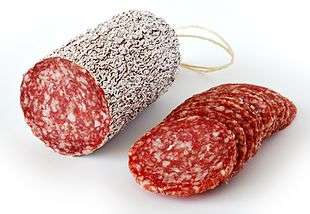Sausage casing
Casing, sausage casing, or sausage skin is the material that encloses the filling of a sausage. Natural casings are made from animal intestines; artificial casings, introduced in the early 20th century, are made of collagen, cellulose, and extruded casings.[1]
Natural casings
Natural sausage casings are made from the sub-mucosa, a layer of the intestine that consists mainly of naturally occurring collagen. In Western European cuisine, most casings come from pigs, but elsewhere the intestines of sheep, goats, cattle and sometimes horses are also used. To prepare the intestines as casings, they are flushed, scraped and cleaned with water and salt by hand or with machinery. The outer fat and the inner mucosa lining are removed during processing. The salt helps preserve the casing. Natural casings have been used in the production of meat specialties for centuries and have remained virtually unchanged in function, appearance, and composition. Organic food regulations only allow natural casings.
Natural casing sausages are distinguishable from mass-produced products because of their irregularity, a signifier of a premium product. Processors of natural casings have developed long-stranded casings with uniformity and strength to support high production volume machinery, as well as new tubing (“shirring”) systems that speed up the stuffing process..
Artificial casings
Artificial casings are made of collagen (often derived from cattle skin), cellulose, or plastic. Artificial casings from animal collagen are generally edible, though some are not.
Collagen
Collagen casings are mainly produced from the collagen in beef or pig hides, and the bones and tendons. It can also be derived from poultry and fish. They have been made for more than 50 years and their share of the market has been increasing. Usually the cost to produce sausages in collagen is significantly lower than making sausages in gut because of higher production speeds and lower labor requirements.
The collagen for artificial casings is processed extensively. It is formed by extrusion through a die to the desired diameter, dried and shirred into short sticks up to 41 cm (16 in) long that contain as much as 50 m (160 ft) of casing. In a newer process, a form of dough is coextruded with the meat blend, and a coating is formed by treating the outside with a calcium solution to set the coating.
The latest generation of collagen casings are usually more tender than natural casings but do not exhibit the “snap” or “bite” of natural casing sausages. Most collagen casings are edible, but a special form of thicker collagen casings is used for salamis and large caliber sausages where the casing is usually peeled off the sausage by the consumer. Collagen casings are less expensive to use, give better weight and size control, and are easier to run when compared to natural casings.
Cellulose
Cellulose, usually from cotton linters or wood pulp, is processed to make viscose, which is then extruded into clear, tough casings for making wieners and franks. They also are shirred for easier use and can be treated with dye to make "red hots". The casing is peeled off after cooking, resulting in "skinless" franks. Cellulosic viscose solutions are combined with wood or for example abaca pulp to make large diameter fibrous casings for bologna, cotto salami, smoked ham and other products sliced for sandwiches. This type is also permeable to smoke and water vapor. They can be flat or shirred, depending on application, and can be pretreated with smoke, caramel color, or other surface treatments.
Plastic casings
Plastic casings are not eaten. They also can be flat or shirred. Generally, smoke and water do not pass through the casing, so plastic is used for non-smoked products where high yields are expected. The inner surface can be laminated or co-extruded with a polymer with an affinity for meat protein causing the meat to stick to the film, resulting in some loss when the casing is peeled, but higher overall yield due to better moisture control.
Plastic casings are generally made from polymers such as polyamide, polypropylene, or polyethylene. Polyamide (Nylon) plastic casings are the most commonly used in production of cooked sausages and hams such as luncheon meat and bologna. Polyamide casings come in two main varieties: Oriented and non-oriented. The oriented polyamide[2] are shrinkable casings and will shrink during the cooking process thereby reducing the water loss. Non-oriented polyamide casings remain the same diameter during the cooking process and thereby allow for expansion of the meat during cooking. The use of polyamide casings has expanded recently with the advent of various varieties and structures of casings such as multilayer casings.[3][4]
Vegetarian Casing
Some innovative coextrusion processes have been developed in recent years, allowing 100% plant-based vegetarian casings to be created. Some special alginate coextrusion equipment is required to make casings that can be used in halal or kosher food making.
References
- ↑ The International Natural Sausage Casing Association (INSCA), INSCA, About Casings Archived December 31, 2010, at the Wayback Machine.
- ↑ Vicik, Stephen James (Dec 11, 2002), A heat shrinkable polyamide sausage casing with a polyolefin core layer, retrieved 2016-11-10
- ↑ U.S. Patent 4,243,074
- ↑ "Archived copy". Archived from the original on 2016-03-13. Retrieved 2013-07-12.
